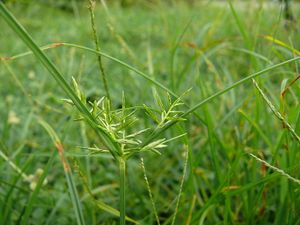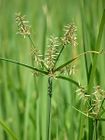Note: This is a project under development. The articles on this wiki are just being initiated and broadly incomplete. You can Help creating new pages.
Difference between revisions of "Cyperus rotundus - Mustaka"
m (Prabhakar moved page Musta to Musta (Cyperus rotundus)) |
(→List of Ayurvedic medicine in which the herb is used) |
||
| (35 intermediate revisions by 2 users not shown) | |||
| Line 1: | Line 1: | ||
[[File:800px-Cyperus rotundus - Kourou.jpg|thumb|right|''Cyperus rotundus'', ''Tunge Gadde'',]] | [[File:800px-Cyperus rotundus - Kourou.jpg|thumb|right|''Cyperus rotundus'', ''Tunge Gadde'',]] | ||
| + | '''Cyperus rotundus''' is a perennial plant that may reach a height of up to 140 cm. It prefers dry conditions, but will tolerate moist soils, and often grows in wastelands and in crop fields.<ref name="Plant family"/> | ||
| + | ==Uses== | ||
| + | {{Uses|Leprosy}}, {{Uses|Excess thirst}}, {{Uses|Fever}}, {{Uses|Liver disorders}}, {{Uses|Blood diseases}}, {{Uses|Biliousness}}, {{Uses|Dysentery}}, {{Uses|Itching}}. | ||
| − | + | ==Parts Used== | |
| − | + | {{Parts Used|Roots}}, {{Parts Used|Seeds}}. | |
| − | + | ==Chemical Composition== | |
| + | Alpha-cyperone (11.0%), myrtenol (7.9%), caryophyllene oxide (5.4%) and beta-pinene (5.3%) were major compounds in the oil of sample A. The main constituents of the oil of sample B were beta-pinene (11.3%), alpha-pinene (10.8%), alpha-cyperone (7.9%), myrtenol (7.1%) and alpha-selinene (6.6%)<ref name="chemical composition"/> | ||
| − | ==Common | + | ==Common names== |
| + | {{Common names|kn=Abdahullu, Koranari-gadde|ml=Karimuttan|sa=Abhrabheda, Ambhodhara|ta=Korai, Korai kilangu|te=Bhadratungamuste|hi=Baranagarmotha|en=Common nut sedge}} | ||
| − | + | ==Properties== | |
| − | + | Reference: Dravya - Substance, Rasa - Taste, Guna - Qualities, Veerya - Potency, Vipaka - Post-digesion effect, Karma - Pharmacological activity, Prabhava - Therepeutics. | |
| − | + | ===Dravya=== | |
| − | == | + | |
| − | + | ===Rasa=== | |
| − | + | Tikta (Bitter), Kashaya (Astringent), Katu (Pungent) | |
| − | <ref name=" | + | ===Guna=== |
| − | </ | + | Laghu (Light), Ruksha (Dry) |
| + | ===Veerya=== | ||
| + | Sheeta (cold) | ||
| + | ===Vipaka=== | ||
| + | Katu (Pungent | ||
| + | ===Karma=== | ||
| + | Kapha, Pitta | ||
| + | ===Prabhava=== | ||
| + | |||
| + | ==Habit== | ||
| + | {{Habit|Perennial plant}} | ||
| + | |||
| + | ==Identification== | ||
| + | ===Leaf=== | ||
| + | {{Leaf|Simple|Aternate|Leaves sprout in ranks of three from the base of the plant}}<ref name="Leaf"/> | ||
| + | |||
| + | ===Flower=== | ||
| + | {{Flower|Bisexual|2-4cm long|Yellow|5-8|Flowers Season is June - August}} | ||
| + | |||
| + | ===Fruit=== | ||
| + | {{Fruit|Three-angled achene|7–10 mm|The root system of a young plant initially forms white, fleshy rhizomes|Fleshy rhizomes|many}} | ||
| + | |||
| + | ===Other features=== | ||
| + | |||
| + | ==List of Ayurvedic medicine in which the herb is used== | ||
| + | [[Bilvādileha]], [[Musta karanjadi kashayam]], [[Mustharishtam]], [[Navaka guggulu]], [[Panchatiktarishta]], [[Lohaasava]] | ||
| + | <ref name="Ayurvedic preparations"/> | ||
| + | |||
| + | ==Where to get the saplings== | ||
| + | ==Mode of Propagation== | ||
| + | {{Propagation|Seeds}}. | ||
| + | |||
| + | ==How to plant/cultivate== | ||
| + | Prefers a moist sandy loam and a sunny position<ref name="How to plant/cultivate"/> | ||
| + | |||
| + | ==Commonly seen growing in areas== | ||
| + | {{Commonly seen|Roadsides}}, {{Commonly seen|Sandy fields}}, {{Commonly seen|Cultivated ground}}, {{Commonly seen|Damp places}}. | ||
| + | |||
| + | ==Photo Gallery== | ||
| + | <gallery class="left" caption="" widths="140px" heights="140px"> | ||
| + | Cyperus cf. rotundus (Mindanao, Philippines).jpg|Feild | ||
| + | Cyperus rotundus - Kourou.jpg|Hole herb | ||
| + | Cyperus rotundus at Kadavoor.jpg|Flower | ||
| + | Cyperus rotundus by kadavoor.JPG|Seeds | ||
| + | Cyperus rotundus Enfoque 2010-7-11 LagunadelaMata.jpg|Seeds | ||
| + | Cyperus rotundus Habitus 2010-7-11 LagunadelaMata cropped.jpg|Leaves | ||
| + | </gallery> | ||
| − | == | + | ==References== |
| − | + | <references> | |
| + | <ref name="chemical composition">[https://www.ncbi.nlm.nih.gov/pubmed/19701133 Chemical composition]</ref> | ||
| + | <ref name="Ayurvedic preparations">[https://easyayurveda.com/2015/01/07/musta-cyperus-rotundus-uses-research-side-effects/ Ayurvedic preparations]</ref> | ||
| + | <ref name="Leaf">[https://www.flowersofindia.net/catalog/slides/Common%20Nut%20Sedge.html Leaves description]</ref> | ||
| + | <ref name="How to plant/cultivate">[https://www.pfaf.org/user/Plant.aspx?LatinName=Cyperus+rotundus Cultivation details]</ref> | ||
| + | <ref name="Plant family">Karnataka Aushadhiya Sasyagalu By Dr.Maagadi R Gurudeva, Page no:101</ref> | ||
| + | </references> | ||
| + | ==External Links== | ||
| + | * [https://www.cropscience.bayer.com/en/crop-compendium/pests-diseases-weeds/weeds/cyperus-rotundus Cyperus rotundus on crop sciences] | ||
| + | * [http://www.iucngisd.org/gisd/species.php?sc=1448 Cyperus rotundus on GLOBAL INVASIVE SPECIES DATABASE ] | ||
| + | * [http://tropical.theferns.info/viewtropical.php?id=Cyperus+rotundus Cyperus rotundus on useful trophical plants] | ||
| + | * [http://articles.extension.org/pages/66868/weed-profile:-yellow-nutsedge-cyperus-esculentus-and-purple-nutsedge-c-rotundus Musta on extension.org] | ||
[[Category:Herbs]] | [[Category:Herbs]] | ||
| + | [[Category:Cyperaceae]] | ||
Latest revision as of 13:09, 2 April 2022
Cyperus rotundus is a perennial plant that may reach a height of up to 140 cm. It prefers dry conditions, but will tolerate moist soils, and often grows in wastelands and in crop fields.[1]
Contents
- 1 Uses
- 2 Parts Used
- 3 Chemical Composition
- 4 Common names
- 5 Properties
- 6 Habit
- 7 Identification
- 8 List of Ayurvedic medicine in which the herb is used
- 9 Where to get the saplings
- 10 Mode of Propagation
- 11 How to plant/cultivate
- 12 Commonly seen growing in areas
- 13 Photo Gallery
- 14 References
- 15 External Links
Uses
Leprosy, Excess thirst, Fever, Liver disorders, Blood diseases, Biliousness, Dysentery, Itching.
Parts Used
Chemical Composition
Alpha-cyperone (11.0%), myrtenol (7.9%), caryophyllene oxide (5.4%) and beta-pinene (5.3%) were major compounds in the oil of sample A. The main constituents of the oil of sample B were beta-pinene (11.3%), alpha-pinene (10.8%), alpha-cyperone (7.9%), myrtenol (7.1%) and alpha-selinene (6.6%)[2]
Common names
| Language | Common name |
|---|---|
| Kannada | Abdahullu, Koranari-gadde |
| Hindi | Baranagarmotha |
| Malayalam | Karimuttan |
| Tamil | Korai, Korai kilangu |
| Telugu | Bhadratungamuste |
| Marathi | NA |
| Gujarathi | NA |
| Punjabi | NA |
| Kashmiri | NA |
| Sanskrit | Abhrabheda, Ambhodhara |
| English | Common nut sedge |
Properties
Reference: Dravya - Substance, Rasa - Taste, Guna - Qualities, Veerya - Potency, Vipaka - Post-digesion effect, Karma - Pharmacological activity, Prabhava - Therepeutics.
Dravya
Rasa
Tikta (Bitter), Kashaya (Astringent), Katu (Pungent)
Guna
Laghu (Light), Ruksha (Dry)
Veerya
Sheeta (cold)
Vipaka
Katu (Pungent
Karma
Kapha, Pitta
Prabhava
Habit
Identification
Leaf
| Kind | Shape | Feature |
|---|---|---|
| Simple | Aternate | Leaves sprout in ranks of three from the base of the plant |
Flower
| Type | Size | Color and composition | Stamen | More information |
|---|---|---|---|---|
| Bisexual | 2-4cm long | Yellow | 5-8 | Flowers Season is June - August |
Fruit
| Type | Size | Mass | Appearance | Seeds | More information |
|---|---|---|---|---|---|
| Three-angled achene | 7–10 mm | The root system of a young plant initially forms white, fleshy rhizomes | Fleshy rhizomes | many | {{{6}}} |
Other features
List of Ayurvedic medicine in which the herb is used
Bilvādileha, Musta karanjadi kashayam, Mustharishtam, Navaka guggulu, Panchatiktarishta, Lohaasava [4]
Where to get the saplings
Mode of Propagation
How to plant/cultivate
Prefers a moist sandy loam and a sunny position[5]
Commonly seen growing in areas
Roadsides, Sandy fields, Cultivated ground, Damp places.
Photo Gallery
References
- ↑ Karnataka Aushadhiya Sasyagalu By Dr.Maagadi R Gurudeva, Page no:101
- ↑ Chemical composition
- ↑ Leaves description
- ↑ Ayurvedic preparations
- ↑ Cultivation details
External Links
- Ayurvedic Herbs known to be helpful to treat Leprosy
- Ayurvedic Herbs known to be helpful to treat Excess thirst
- Ayurvedic Herbs known to be helpful to treat Fever
- Ayurvedic Herbs known to be helpful to treat Liver disorders
- Ayurvedic Herbs known to be helpful to treat Blood diseases
- Ayurvedic Herbs known to be helpful to treat Biliousness
- Ayurvedic Herbs known to be helpful to treat Dysentery
- Ayurvedic Herbs known to be helpful to treat Itching
- Herbs with Roots used in medicine
- Herbs with Seeds used in medicine
- Herbs with common name in Kannada
- Herbs with common name in Hindi
- Herbs with common name in Malayalam
- Herbs with common name in Tamil
- Herbs with common name in Telugu
- Herbs with common name in Sanskrit
- Herbs with common name in English
- Habit - Perennial plant
- Index of Plants which can be propagated by Seeds
- Herbs that are commonly seen in the region of Roadsides
- Herbs that are commonly seen in the region of Sandy fields
- Herbs that are commonly seen in the region of Cultivated ground
- Herbs that are commonly seen in the region of Damp places
- Herbs
- Cyperaceae






